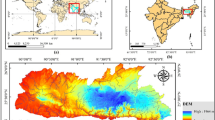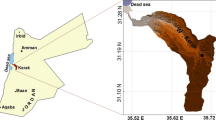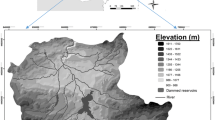Abstract
Soil erosion is a life-threatening hazard ravaging and displacing many communities in Anambra State, Nigeria. Most erosion studies in this region have been based on geological and geotechnical analyses of soils from gullies. In this paper, the soil erosion risk of Anambra State was evaluated using the Revised Universal Soil Loss Equation (RUSLE) and geoinformatics, to estimate the rate of soil loss and identify vulnerable erosion zones. The RUSLE model was based on five erosion factors (rainfall erosivity (R), soil erodibility (K), topography (LS), vegetation cover (C), and anti-erosion practices (P)). The R-factor ranged from 460.51 to 582.08 MJ/mm/ha−1 h−1 year−1 whereas the K-factor ranged from 0.100 to 0.310 t/h/MJ−1/mm−1. Low–moderate LS-factor values dominated the northern and western portions of the State. However, moderate–high LS-factor scores dominated the eastern and southern portions. The C-factor varied from 0 (in areas covered by water bodies) to 1 (for barren lands). The P-factor ranged from 0.5–1. These five factors were integrated to generate soil loss rates across Anambra. The average annual soil loss ranged from 0 to over 6 t/ha−1 year−1. The soil loss results showed that about 5% (242.2 km2), 25% (1211 km2), 30% (1453.2 km2), and 40% (1937.6 km2) of the total area have very low, low, medium, and high erosion risks, respectively. The northern and western portions of the State were characterized by very low, low, and moderate soil loss. However, the eastern and southern portions were characterized by high soil loss rate. It was indicated that LS, K, and R are the most important soil loss factors in Anambra.








Similar content being viewed by others
References
Akpan AE, George NJ, George AM (2009) Geophysical investigation of some prominent gully erosion sites in Calabar, southeastern Nigeria and its implications to hazard prevention. Disaster Adv 2:46–50
Annayat W, Sil BS (2020a) Assessing channel morphology and prediction of centerline channel migration of the Barak River using geospatial techniques. Bull Eng Geol Environ 1–23. https://doi.org/10.1007/s10064-020-01894-9
Annayat W, Sil BS (2020b) Changes in morphometric meander parameters and prediction of meander channel migration for the alluvial part of the Barak River. J Geol Soc India 96(3):279–291
Baumann V, Bonadonna C, Cuomo S, Moscariello M (2020) Modelling of erosion processes associated with rainfall-triggered lahars following the 2011 Cordon Caulle eruption (Chile). J Volcanol Geotherm Res 390
Chadli K (2016) Estimation of soil loss using RUSLE model for Sebou watershed (Morocco). Model Earth Syst Environ 2:51. https://doi.org/10.1007/s40808-016-0105-y
Chikwelu EE, Ogbuagu FU (2014) Geotechnical investigation of soil around Mbaukwu gully erosion sites. South-Eastern Part of Nigeria JAGG 2(4):6–17
Choudhury MK, Nayak T (2003) Estimation of soil erosion in Sagar Lake catchment of Central India. In: Proceedings of the International Conference on Water and Environment 387–392
Cuomo S, Chareyre B, d’Arista P, Della Sala M, Cascini L (2016) Micromechanical modelling of rainsplash erosion in unsaturated soils by discrete element method. CATENA 147:146–152
Cuomo S, Della Sala M (2013) Rainfall-induced infiltration, runoff and failure in steep unsaturated shallow soil deposits. Eng Geol 162:118–127
Dabral PP, Baithuri N, Pandey A (2008) Soil erosion assessment in a hilly catchment of North Eastern India using USLE, GIS and remote sensing. Water Resour Manage 22(12):1783–1798
Darabi H, Rahmati O, Naghibi SA, Mohammadi F, Ahmadisharaf E, Kalantari Z, Haghighi AT, Soleimanpour SM, Tiefenbacher JP, Bui DT (2021) Development of a novel hybrid multi-boosting neural network model for spatial prediction of urban flood. Geocarto Int. https://doi.org/10.1080/10106049.2021.1920629
Das B, Paul A, Bordoloi R, Tripathi OP, Pandey PK (2018) Soil erosion risk assessment of hilly terrain through integrated approach of RUSLE and geospatial technology: a case study of Tirap District, Arunachal Pradesh. Model Earth Syst Environ. https://doi.org/10.1007/s40808-018-0435-z
Djoukbala O, Hasbaia M, Benselama O, Mazour M (2018) Comparison of the erosion prediction models from USLE, MUSLE and RUSLE in a Mediterranean watershed, case of Wadi Gazouana (N-W of Algeria). Model Earth Syst Environ. https://doi.org/10.1007/s40808-018-0562-6
Dutta D, Das S, Kundu A, Taj A (2015) Soil erosion risk assessment in Sanjal watershed, Jharkhand (India) using geo-informatics, RUSLE model and TRMM data. Model Earth Syst Environ 1:37. https://doi.org/10.1007/s40808-015-0034-1
Egboka BCE, Nwankwor GI (1985) Hydrogeological and geotechnical parameters as agents for gully-type erosion in the rain-forest belt of Nigeria. J Afr Earth Sci 417–425
Egboka BCE, Okpoko EI (1984) Gully erosion in the Agulu-Nanka region of Anambra State, Nigeria. Challenges in African Hydrology and Water Resources: Proceedings of the Harare Symposium, IAHS Publ 144:335–347
Egbueri JC, Igwe O (2020) The impact of hydrogeomorphological characteristics on gullying processes in erosion-prone geological units in parts of southeast Nigeria. Geology, Ecology, and Landscapes. https://doi.org/10.1080/24749508.2020.1711637
Egbueri JC (2021) Prediction modeling of potentially toxic elements’ hydrogeopollution using an integrated Q–mode HCs and ANNs machine learning approach in SE Nigeria. Environ Sci Pollut Res 28(30):40938–40956. https://doi.org/10.1007/s11356-021-13678-z
Egbueri JC, Igwe O (2021) Development of a novel numerical indicator (DLPI) for assessing the detachability and liquefaction potentials of soils from erosion-prone areas. Model Earth Syst Environ 7(4):2407–2429. https://doi.org/10.1007/s40808-020-00999-0
Egbueri JC, Igwe O, Nnamani CH (2017) Assessment of the Engineering Properties and Suitability of some Tropical Soils as Backfill Materials. Int J Trend Res Dev 2(1):590–605. https://doi.org/10.31142/ijtsrd7041
Egbueri JC, Igwe O, Unigwe CO (2021) Gully slope distribution characteristics and stability analysis for soil erosion risk ranking in parts of southeastern Nigeria: a case study. Environ Earth Sci 80(7):292. https://doi.org/10.1007/s12665-021-09605-7
Ejikeme JO, Ojiako JC, Onwuzuligbo CU, Ezeh FC (2017) Enhancing food security in Anambra State, Nigeria using remote sensing data. Environ Rev 6(1):27–44
Erencin Z (2000) C-Factor Mapping Using Remote Sensing and GIS; A case Study of Lom Sak/Lom Kao, Thailand. International Institute for Aerospace Survey and Earth Sciences (ITC): Upper Aise, The Netherlands
Ganasri BP, Ramesh H (2016) Assessment of soil erosion by RUSLE model using remote sensing and GIS—a case study of Nethravathi Basin. Geosci Front 7:953–961
Gashaw T, Tulu T, Argaw M (2017) Erosion risk assessment for prioritization of conservation measures in Geleda watershed, Blue Nile basin. Ethiopia Environ Syst Res 6:1. https://doi.org/10.1186/s40068-016-0078-x
Halefom A, Teshome A (2018) Modelling and mapping of erosion potentiality watersheds using AHP and GIS technique: a case study of Alamata Watershed, South Tigray, Ethiopia. Model Earth Syst Environ. https://doi.org/10.1007/s40808-018-00568-6
Huang F, Chen J, Yao C, Chang Z, Jiang Q, Li S, Guo Z (2020) SUSLE: a slope and seasonal rainfall-based RUSLE model for regional quantitative prediction of soil erosion. Bull Eng Geol Environ. https://doi.org/10.1007/s10064-020-01886-9
Hudec PP, Simpson F, Akpokodje EG, Umenweke MO (2006) Termination of gully processes, Southeastern Nigeria. Proceedings of the Eighth Federal Interagency Sedimentation Conference (8th FISC), Reno, NV, USA, 671–679
Igbokwe JI, Akinyede JOB, Dang BT, Alaga TMN, Ono MN, Nnodu VC, Anike LO (2008) Mapping and monitoring of the impact of gully erosion in southeastern Nigeria with satellite remote sensing and geographic information system. The International Archives of the Photogrammetry. Remote Sens Spat Inf Sci 37:865–871
Igwe CA (2012) Gully erosion in southeastern Nigeria: role of soil properties and environmental factors. Research on Soil Erosion, G. Danilo, Ed. InTech. https://doi.org/10.5772/51020
Igwe O, Egbueri JC (2018) The characteristics and the erodibility potentials of soils from different geologic formations in Anambra State, Southeastern Nigeria. J Geol Soc India 92(4):471–478. https://doi.org/10.1007/s12594-018-1044-1
Kadam AK, Jaweed TH, Kale SS, Umrikar BN, Sankhua RN (2019) Identification of erosion-prone areas using modified morphometric prioritization method and sediment production rate: a remote sensing and GIS approach. Geomat Nat Haz Risk 10(1):986–1006
Kayet N, Pathak K, Chakrabarty A, Sahoo S (2018) Evaluation of soil loss estimation using the RUSLE model and SCS-CN method in hillslope mining areas. International Soil and Water Conservation Research 6:31–42. https://doi.org/10.1016/j.iswcr.2017.11.002
Koirala P, Thakuri S, Joshi S, Chauhan R (2019) Estimation of soil erosion in Nepal using a RUSLE modeling and geospatial tool. Geosciences 9:147. https://doi.org/10.3390/geosciences9040147
Kumar S, Kushwaha SPS (2013) Modelling soil erosion risk based on RUSLE-3D using GIS in a Shivalik sub-watershed. J Earth Syst Sci 122:389–398
Marzolff I, Poesen J (2009) The potential of 3D gully monitoring with GIS using high-resolution aerial photography and a digital photogrammetry system. Geomorphology 111:48–60
Moore ID, Burch GJ (1986) Physical basis of the length slope factor in the Universal Soil Loss Equation. Soil Sci Soc Am 50:1294–1298
Morgan PRC (1995) Soil erosion and conservation. Longman Group, Essex
Morgan RPC (1986) Soil erosion and conservation. Essex, Longman Group UK Ltd. p 295
Morgan RPC (2005) Soil erosion and conservation, 3rd edn. Blackwell Science Ltd, USA
Nebeokike UC, Igwe O, Egbueri JC, Ifediegwu SI (2020) Erodibility characteristics and slope stability analysis of geological units prone to erosion in Udi area, southeast Nigeria. Model Earth Syst Environ 6(2):1061–1074. https://doi.org/10.1007/s40808-020-00741-w
Nitheshnirmal S, Thilagaraj P, Abdul-Rahaman S, Jegankumar R (2019) Erosion risk assessment through morphometric indices for prioritisation of Arjuna watershed using ALOS-PALSAR DEM. Model Earth Syst Environ. https://doi.org/10.1007/s40808-019-00578-y
Nwajide CS (2013) Geology of Nigeria’s sedimentary basins. CSS Press, Lagos, Nigeria
Nwozor KK (2010) An Extract on the Geology and Pedology of Anambra State: Implications for Gully Erosion Control and Management. Giant NUSSA Magazine, 2nd Ed. 19–20
Obiadi II, Nwosu CM, Ajaegwu NE, Anakwuba EK, Onuigbo NE, Akpunonu EO, Ezim OE (2014) Gully erosion in Anambra State, South East Nigeria: Issues and Solution. IJES 2(2):796–804
Okoyeh EI, Akpan AE, Egboka BCE, Okeke HI (2014) An assessment of the influences of surface and subsurface water level dynamics in the development of Gullies in Anambra State, Southeastern Nigeria. Earth Interact 18:1–24
Owusu G (2012) A GIS-based estimation of soil loss in the Densu Basin in Ghana. West Afr J Appl Ecol 20(2):41–52
Ozioko OH, Igwe O (2019) GIS-based landslide susceptibility mapping using heuristic and bivariate statistical methods for Iva Valley and environs, Southeast Nigeria. Environ Monit Assess. https://doi.org/10.1007/s10661-019-7951-9
Panagos P, Borrelli P, Meusburger K, Alewell C, Lugato E, Montanarella L (2015) Estimating the soil erosion cover-management factor at the European scale. Land Use Policy 48:38–50
Renard KG, Foster GR, Weesies GA, McCool DK, Yoder DC (1997) Predicting soil erosion by water: a guide to conservation planning with the revised universal soil loss equation (RUSLE). Agriculture handbook, 703. USDA, Washington, DC, pp 1–251
USDA (U.S. Department of Agriculture) (1981) Rainfall erosion losses from cropland east of the rocky mountain. Handbook no. 282. U.S. Department of Agriculture, Washington, DC
Wijesundara NC, Abeysingha NS, Dissanayake DMSLB (2018) GIS-based soil loss estimation using RUSLE model: a case of Kirindi Oya river basin, Sri Lanka. Model Earth Syst Environ. https://doi.org/10.1007/s40808-018-0419-z
Wischmeier WH, Smith DD (1978) Predicting rainfall erosion losses. Agriculture Handbook No. 537. US Department of Agriculture, Washington, DC, pp 285–291
Yadav RP, Aggarwal RK, Bhattacharyya P, Bansal RC (2005) Infiltration characteristics of different aspects and topographical locations of hilly watershed in Shivalik-lower Himalayan region in India. India J Soil Conserv 33:44–48
Youe-Qing X, Xiao-Mei S, Xiang-Bin K, Jian P, Yun-Long C (2008) Adapting the RUSLE and GIS to model soil erosion risk in a mountains Karst watershed, Guizhou Province. China Environ Monit Assess 141(1–3):275–286
Acknowledgements
The first author is very grateful for the financial support provided by The Obinenwu Foundation (TOF). All the authors are grateful to the anonymous reviewers that provided comments that helped us improve the quality of the manuscript.
Funding
The Obinenwu Foundation (TOF), 001, Johnbosco C. Egbueri.
Author information
Authors and Affiliations
Corresponding author
Ethics declarations
Conflict of interest
The authors declare no competing interests.
Rights and permissions
About this article
Cite this article
Egbueri, J.C., Igwe, O. & Ifediegwu, S.I. Erosion risk mapping of Anambra State in southeastern Nigeria: soil loss estimation by RUSLE model and geoinformatics. Bull Eng Geol Environ 81, 91 (2022). https://doi.org/10.1007/s10064-022-02589-z
Received:
Accepted:
Published:
DOI: https://doi.org/10.1007/s10064-022-02589-z




